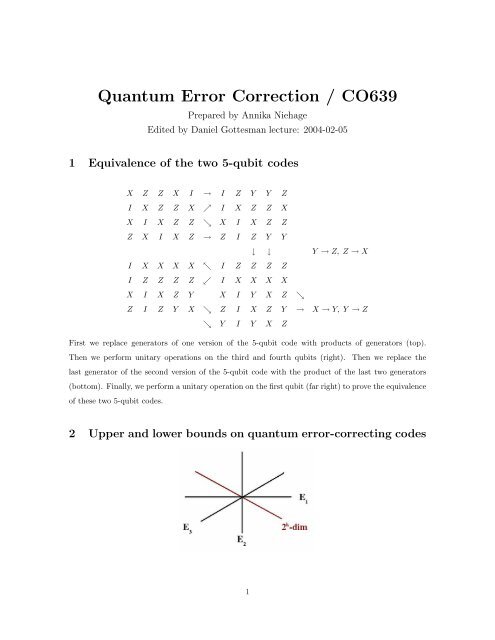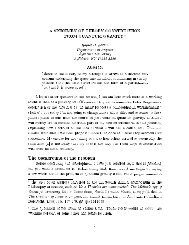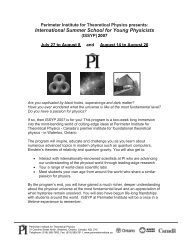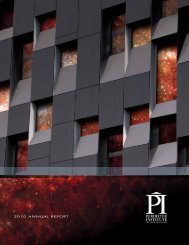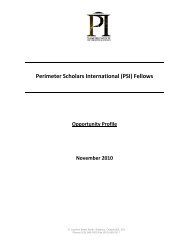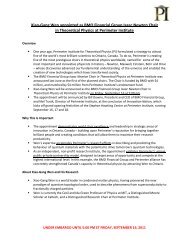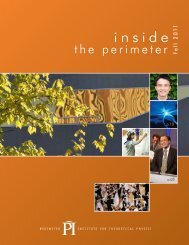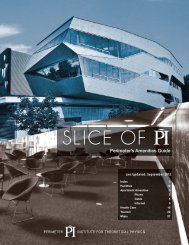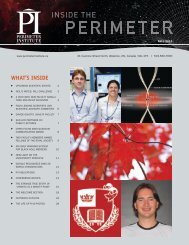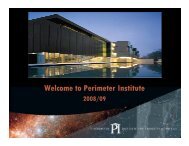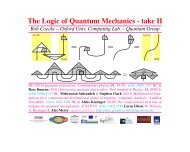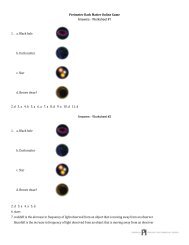Quantum Error Correction / CO639 - Perimeter Institute
Quantum Error Correction / CO639 - Perimeter Institute
Quantum Error Correction / CO639 - Perimeter Institute
You also want an ePaper? Increase the reach of your titles
YUMPU automatically turns print PDFs into web optimized ePapers that Google loves.
<strong>Quantum</strong> <strong>Error</strong> <strong>Correction</strong> / <strong>CO639</strong><br />
Prepared by Annika Niehage<br />
Edited by Daniel Gottesman lecture: 2004-02-05<br />
1 Equivalence of the two 5-qubit codes<br />
X Z Z X I → I Z Y Y Z<br />
I X Z Z X ↗ I X Z Z X<br />
X I X Z Z ↘ X I X Z Z<br />
Z X I X Z → Z I Z Y Y<br />
↓ ↓ Y → Z, Z → X<br />
I X X X X ↖ I Z Z Z Z<br />
I Z Z Z Z ↙ I X X X X<br />
X I X Z Y X I Y X Z ↘<br />
Z I Z Y X ↘ Z I X Z Y → X → Y, Y → Z<br />
↘ Y I Y X Z<br />
First we replace generators of one version of the 5-qubit code with products of generators (top).<br />
Then we perform unitary operations on the third and fourth qubits (right). Then we replace the<br />
last generator of the second version of the 5-qubit code with the product of the last two generators<br />
(bottom). Finally, we perform a unitary operation on the first qubit (far right) to prove the equivalence<br />
of these two 5-qubit codes.<br />
2 Upper and lower bounds on quantum error-correcting codes<br />
1
For a non-degenerate code<br />
N E errors occur; each gives a 2 k − dim subspace of a 2 n − dim total space (n qubits). So we get<br />
N E 2 k ≤ 2 n<br />
2.1 <strong>Quantum</strong> Hamming bound (QHB)<br />
Theorem:<br />
A non-degenerate QECC correcting t errors with n qubits and k encoded qubits satisfies<br />
⎡<br />
⎤<br />
t∑<br />
( )<br />
⎣ n<br />
3 j ⎦ 2 k ≤ 2 n<br />
j<br />
j=0<br />
} {{ }<br />
N E<br />
Example:<br />
Take t = 1: (1 + 3n)2 k ≤ 2 n<br />
If you set k = 1, you get: 1 + 3n ≤ 2 n−1<br />
The smallest possible n is n = 5.<br />
⇒ 5-qubit code saturates QHB and is called “perfect”. In general a code is called perfect, if we have<br />
= in the QHB.<br />
1 + 3n = 2 n−k<br />
2 2s ≡ 1 mod 3<br />
n = 43 −1<br />
3<br />
, n − k = s<br />
For certain values of s we get:<br />
s = 2 : n = 5<br />
s = 3 : n = 21<br />
s = 4 : n = 85<br />
What happens if n → ∞?<br />
The rates t n and k n<br />
should be constant. Then we get:<br />
( n<br />
)<br />
log 2 N E ≈ log 2 +t log<br />
} {{<br />
t<br />
2 3<br />
}<br />
n h( t n )<br />
with h(x) = −x log 2 x − (1 − x) log 2 (1 − x), called the binary entropy function. So<br />
k<br />
n ≤ 1 − h( t n ) − t n log 2 3<br />
2
2.2 <strong>Quantum</strong> Singleton bound (“Knill-Laflamme” bound) (QSB)<br />
Remember:<br />
Correcting t errors ⇔ correcting 2t = d − 1 erasure errors.<br />
If we had an n-qubit code correcting ≥ n 2<br />
erasure errors, we could clone states, so n > 2(d − 1).<br />
Theorem (QSB):<br />
k ≤ n − 2(d − 1)<br />
e.g. the following codes saturate the bound: [[5, 1, 3]], [[4, 2, 2]], [[n, n − 2, 2]] (n even).<br />
Codes which saturate the QSB are called “MDS” codes. (MDS comes from the classical case and<br />
stands for “maximum distance separable codes”).<br />
Proof: Take a QECC and k EPR pairs. Encode 1 2<br />
you have the following:<br />
of each pair in QECC, call the other half R. Then<br />
k<br />
{}}{<br />
R<br />
d−1<br />
{}}{<br />
A<br />
d−1<br />
{}}{<br />
B<br />
n−2(d−1)<br />
{}}{<br />
C<br />
The entropy is defined as the following: S(ρ) = −tr ρ log 2 ρ.<br />
S(RA) = S(BC) (pure state)<br />
S(RB) = S(AC)<br />
3
As the QECC has distance d<br />
⇒ any d − 1 qubits are independant of the encoded state<br />
⇒ ρ(RA) = ρ(R) ⊗ ρ(A)<br />
S(RA) = S(R) + S(A)<br />
S(RB) = S(R) + S(B)<br />
Subadditivity gives us:<br />
S(BC) ≤ S(B) + S(C)<br />
S(AC) ≤ S(A) + S(C)<br />
Combining these results, we get:<br />
k = S(R) ≤ S(C) + [S(B) − S(A)]<br />
k = S(R) ≤ S(C) + [S(A) − S(B)]<br />
⇒ k ≤ S(C)<br />
S(C) ≤ n − 2(d − 1)<br />
<br />
2.3 <strong>Quantum</strong> Gilbert-Varshamov bound (QGVB)<br />
Existence of QECC:<br />
Stabilizer code [[n, k, d]]<br />
• Write down all [[n, k]] stabilizer codes (♯ = N C )<br />
• For each code, list all elements in N(S)\S; each list has 2 n+k − 2 n−k elements.<br />
• Each E ∈ P\{I} appears on the same number of lists:<br />
E, F ∈ P\{I}<br />
⇒ ∃ U ∈ C s.t. U(E) = F<br />
S stab. [[n, k]] ⇔ U(S) stab. [[n, k]] also<br />
E ∈ N(S)\S ⇔ F ∈ N(U(S))\U(S)<br />
• Each E ∈ P\{I} appears on<br />
lists.<br />
N C (2 n+k − 2 n−k )<br />
4 n − 1<br />
• Cross off each code that fails to correct E with wt(E) < d.<br />
In the end we crossed off at most N E<br />
N C (2 n+k −2 n−k )<br />
4 n −1<br />
codes. If this is < N C , then ∃ [[n, k, d]].<br />
4
Theorem (QGVB):<br />
A QECC correcting t errors with n qubits and k encoded qubits exists, if<br />
⎡<br />
⎤<br />
∑d−1<br />
( )<br />
⎣ n<br />
3 j ⎦ 2 k ≤ 2 n<br />
j<br />
j=0<br />
⇔ k n ≤ 1 − h( d n ) − d n log 2 3<br />
5


